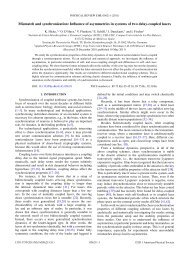DBI Analysis of Open String Bound States on Non-compact D-branes
DBI Analysis of Open String Bound States on Non-compact D-branes
DBI Analysis of Open String Bound States on Non-compact D-branes
Create successful ePaper yourself
Turn your PDF publications into a flip-book with our unique Google optimized e-Paper software.
CHAPTER 5. BRANES 66i.e. our original Neumann boundary c<strong>on</strong>diti<strong>on</strong>s got transformed into Dirichlet boundaryc<strong>on</strong>diti<strong>on</strong>s! Had we started out with Dirichlet boundary c<strong>on</strong>diti<strong>on</strong>s, it is easy to seefrom Eq. 2.39 that the same would have happened but the other way around, i.e. wewould have found that D boundary c<strong>on</strong>diti<strong>on</strong>s got turned into N boundary c<strong>on</strong>diti<strong>on</strong>s.Furthermore, we note that˜X 25 (π, τ) − ˜X 25 (0, τ) = 2π ˜Rn, (5.28)meaning our string has to wrap an integer time around the T-dualized circle. This isquite an interesting observati<strong>on</strong>, given that if a string has Neumann boundary c<strong>on</strong>diti<strong>on</strong>sin some (<strong>compact</strong>) directi<strong>on</strong>, it can not have a winding number in that directi<strong>on</strong>.Intuitively this is clear: the string can move freely in that directi<strong>on</strong>, so nothing can forceit to keep its endpoints fixed. But since it can move, it also gains momentum. In theT-dual picture, this observati<strong>on</strong> gets inversed: the string endpoints become fixed, so itcan wind (and as Eq. 5.28 shows, it is even forced to), but since it cannot move, itcannot gain any momentum.The crucial point in all this, is that as far as closed strings are c<strong>on</strong>cerned, thereis no physically significant difference between <strong>compact</strong>ificati<strong>on</strong> <strong>on</strong> a circle <str<strong>on</strong>g>of</str<strong>on</strong>g> radius R,or a circle <str<strong>on</strong>g>of</str<strong>on</strong>g> radius ˜R = α ′ /R. For open strings however, this is not the same, andthat is something we do not like, because T-duality seemed like a really nice idea andvery powerful tool. So how can we fix this awkward little problem? Answer: introduceD-<strong>branes</strong>! So in order to make sense <str<strong>on</strong>g>of</str<strong>on</strong>g> this picture, it has been proposed (and thispropositi<strong>on</strong> has since been developped in full glory) that an open string with Dirichletboundary c<strong>on</strong>diti<strong>on</strong>s does not have its endpoints fixed to some arbitrary points in spacetimethat somehow are more special than their neighbours, but instead that its endpointslie <strong>on</strong> the surface <str<strong>on</strong>g>of</str<strong>on</strong>g> a physical object that lives in (p + 1)-dimensi<strong>on</strong>al space-time. Theendpoints <str<strong>on</strong>g>of</str<strong>on</strong>g> the string are free to move <strong>on</strong> this surface, but are bound to remain fixed indirecti<strong>on</strong>s perpendicular to it. This object is called a Dp-brane, with the D referencingto Dirichlet for obvious reas<strong>on</strong>s. So in the case <str<strong>on</strong>g>of</str<strong>on</strong>g> our original string that had Neumannboundary c<strong>on</strong>diti<strong>on</strong>s in all 25 spatial dimensi<strong>on</strong>s, we can now interpret this as an openstring whose endpoints live <strong>on</strong> the surface <str<strong>on</strong>g>of</str<strong>on</strong>g> a space-time-filling D25-brane. Since thesurface <str<strong>on</strong>g>of</str<strong>on</strong>g> this D-brane comprises all <str<strong>on</strong>g>of</str<strong>on</strong>g> space-time, the open string is free to move as itpleases. When we <strong>compact</strong>ify the X 25 directi<strong>on</strong> and T-dualize it however, what happens“underneath the surface” is that we remove <strong>on</strong>e dimensi<strong>on</strong> <str<strong>on</strong>g>of</str<strong>on</strong>g> our D-brane, making it aD24-brane that does no l<strong>on</strong>ger extend in the X 25 directi<strong>on</strong>. Hence, since this brane stilllives in a 25 spatial-dimensi<strong>on</strong>al world, its positi<strong>on</strong> must be fixed in the X 25 dimensi<strong>on</strong>, 3which explains why suddenly our open string gains Dirichlet boundary c<strong>on</strong>diti<strong>on</strong>s in thisdirecti<strong>on</strong> and is forced to wrap an integer number <str<strong>on</strong>g>of</str<strong>on</strong>g> times around it.This idea can easily be generalized to <strong>compact</strong>ificati<strong>on</strong> <str<strong>on</strong>g>of</str<strong>on</strong>g> more than <strong>on</strong>e spatialdimensi<strong>on</strong>. Remark however that because an open string wraps around a circular directi<strong>on</strong>,and hence has both its endpoints identified in this directi<strong>on</strong>, does not make ita closed string! The endpoints can still take <strong>on</strong> different values in the other directi<strong>on</strong>s.3 C<strong>on</strong>sider e.g. a disc in the x − y plane that lives in a 3D world. If this disc cannot move in the zdirecti<strong>on</strong>, when we project it <strong>on</strong>to the z-axis it is bound to take <strong>on</strong> a fixed value.
















